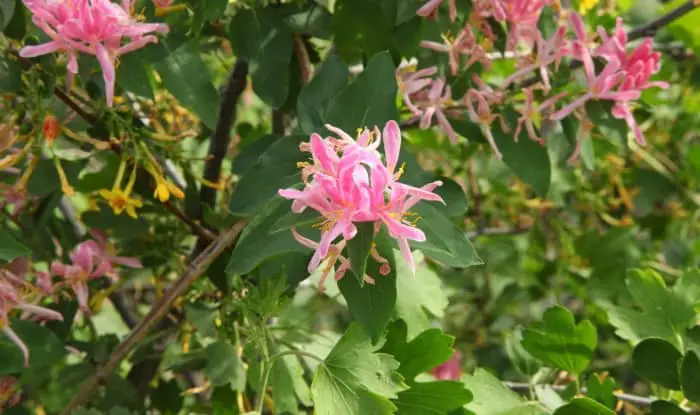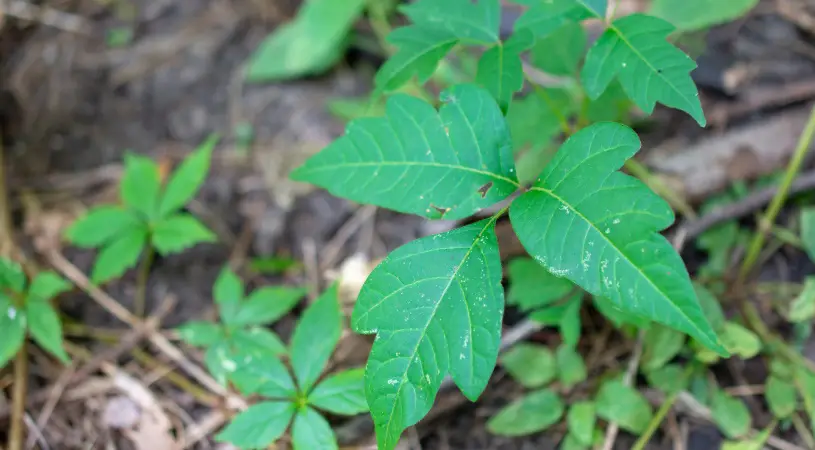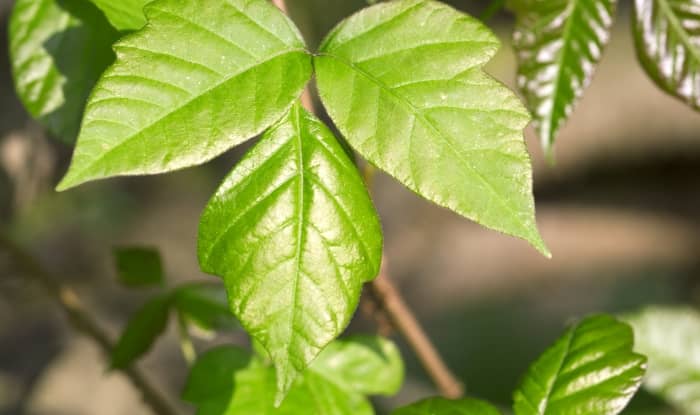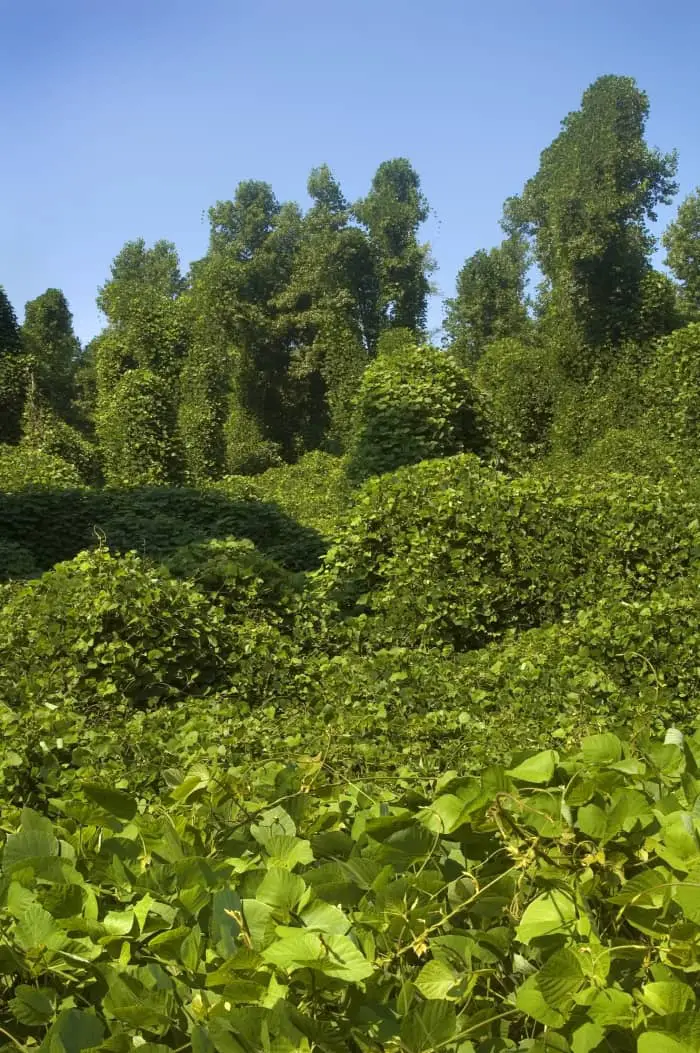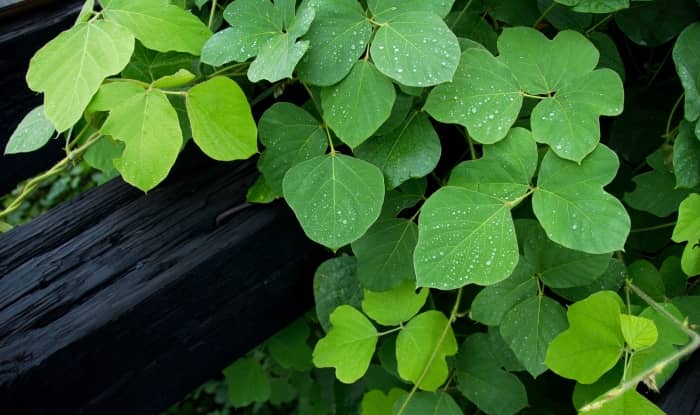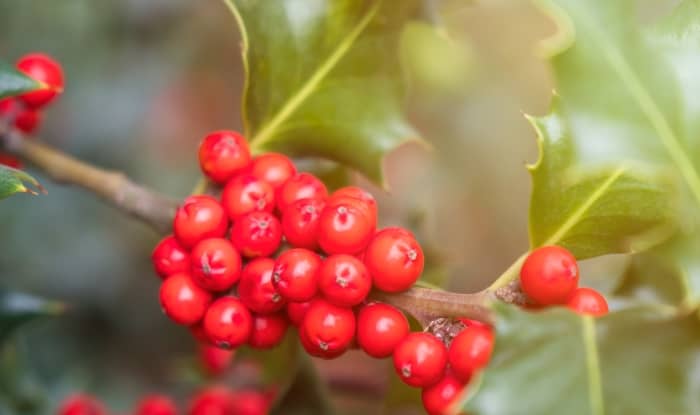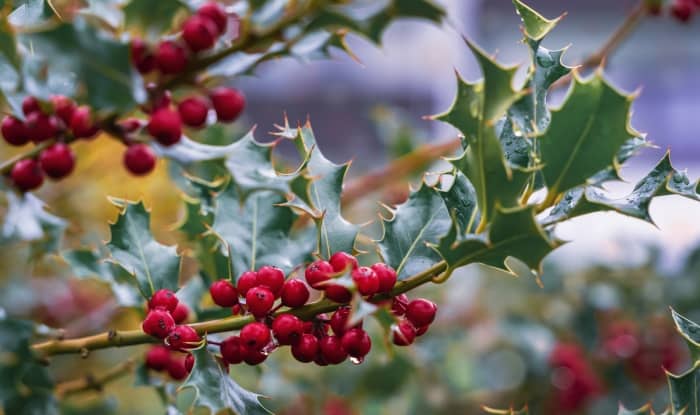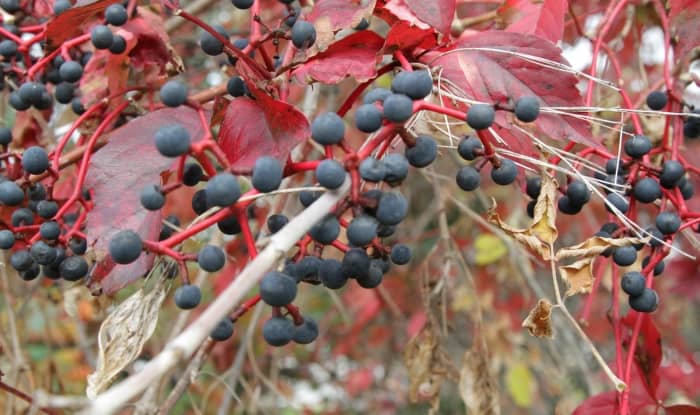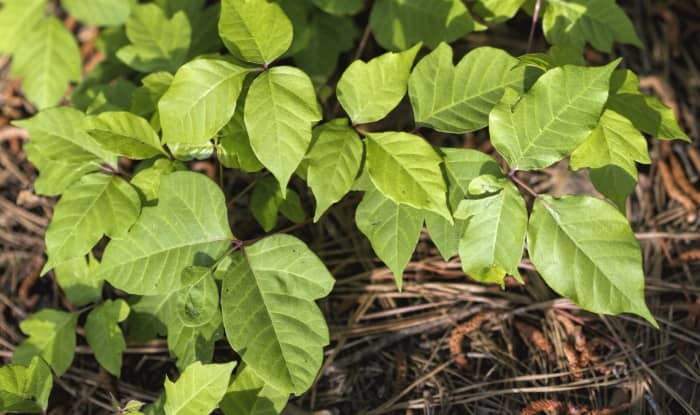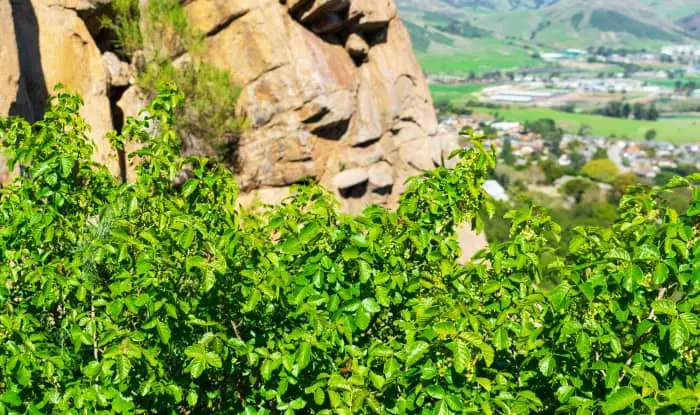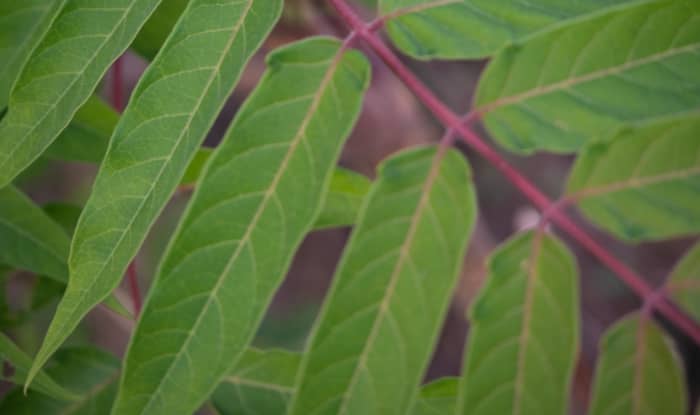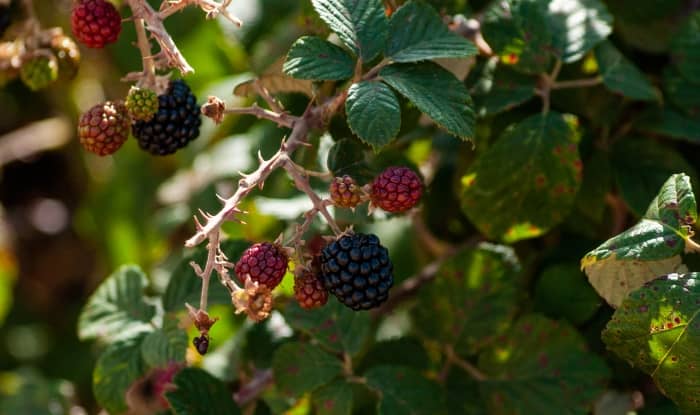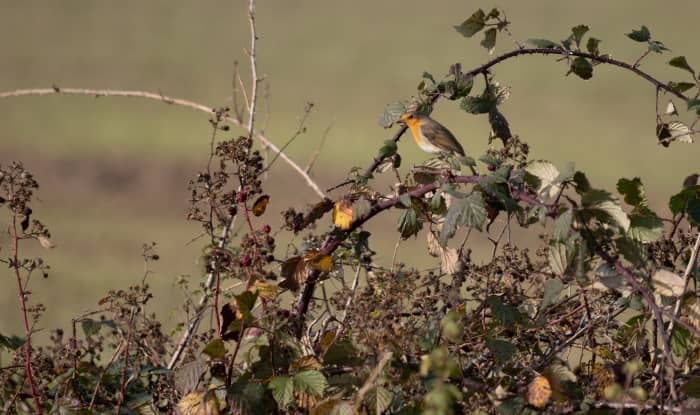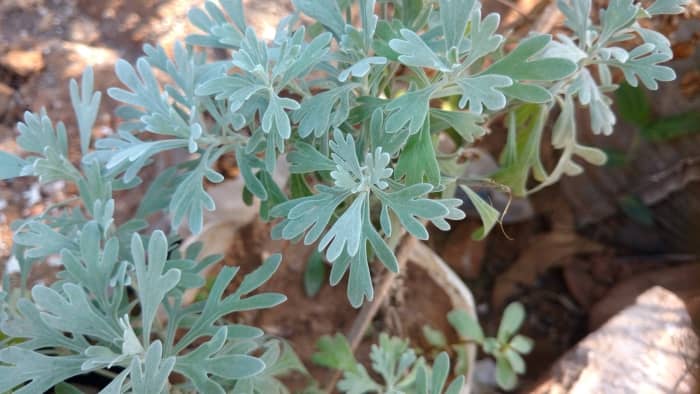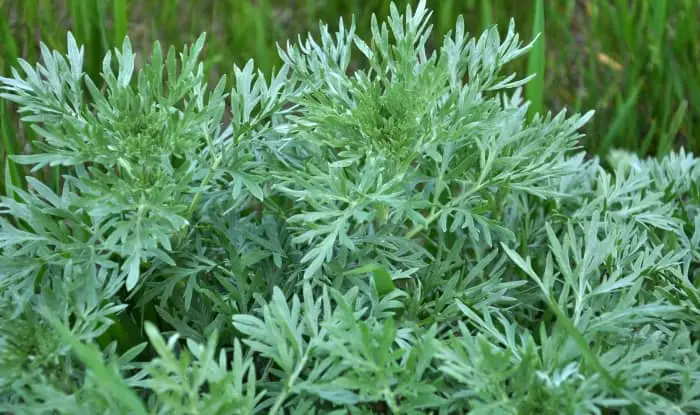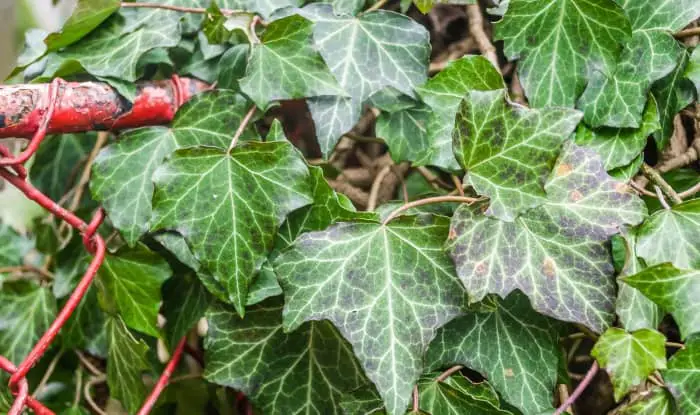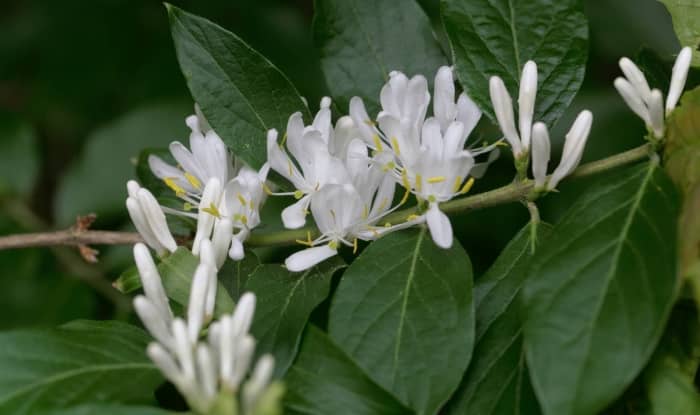Have you discovered a woody weed growing on your property?
We’ve compiled this list of some of the most common woody weeds with photos and descriptions to make identification easy.
Let’s dive in.
Woody Weeds Examples
What are woody weeds?
Woody weeds can be trees, shrubs, or vines. They can be weeds with woody stems, weeds with woody roots, or both. They are perennial weeds and are usually eudicots, but some can belong to a different plant group.
Here are some of the most common types of woody weeds:
Poison Ivy (Toxicodendron radicans)
Poison ivy is a noxious woody weed that grows as a groundcover, a shrub, or a climbing vine weed. Poison ivy is well-known for the uncomfortable rash that develops after you touch it, so be careful if you find this vine weed in your turf grass. The rash is caused by an oily resin called urushiol that’s present in the leaves, stems, and roots, making it one of the worst weeds to handle, so make sure you wear gloves.
You can identify poison ivy by its compound leaves consisting of 3 leaflets. The leaves grow alternately from a woody stem that’s sometimes tinged red. The leaves on young poison ivy plants are often reddish in the spring before turning shiny green. The leaves change to dull green in the summer and then turn yellow or scarlet in the fall.
Poison ivy is a perennial woody weed that loses its leaves in the winter, but the hairy vines remain. The weed regrows the leaves in the spring.
Poison ivy grows in various soil conditions, thriving in moist and very dry soil. And it grows in partial shade to full sun, sending out vines that can sometimes reach 60 ft. or more (1).
You can control poison ivy with repeated cutting as it exhausts the root system, but it can take several years to kill the plant.
Kudzu (Pueraria montana)
Kudzu is an invasive weed introduced to the US from Asia. Its rapid spread has been devastating for the environment, with conditions allowing it to grow unchecked. And kudzu is now officially classified as a noxious weed.
Kudzu is a woody vine with large leaflets. Nodes along the vine propagate new stems allowing the plant to climb easily. The nodes also root where they touch the soil, anchoring the woody weed in the ground. Kudzu prefers to grow in full sunlight. But this weed also thrives in the shade.
To control kudzu, cut or mow the vine to the ground before treating the woody stumps with chemical herbicides. It sometimes takes multiple applications and several seasons to stop kudzu from regrowing.
English Holly (Ilex aquifolium)
English holly is also known as Christmas holly, and the name is often abbreviated to holly. Holly is an introduced plant in the United States where it’s grown as a landscape plant. But in many areas, holly is now an invasive woody weed that outcompetes native shrubs in the areas where it spreads, often in forests.
Holly is a slow-growing evergreen shrub or small tree. When it’s unwanted, holly is a tall woody weed that reaches from 15-50 ft. tall and 15 ft. or wider. Holly has woody stems and leaves that are oval-shaped and shiny.
The leaves are dark green on the upper surface and light green underneath and grow alternately on petioles from the stems, reaching 2-5 inches long. The leaves are thick, and young leaves are spiky, with sharp spines on the sides that often smooth out as they get older.
Holly blooms in the spring, producing sweet-scented small, white flowers that change into orange, yellow, or red berries in the winter. The berries are poisonous to people and many animals, but not to birds that disperse the seeds and help the weed to spread. Check out our guide to weeds with red berries.
Virginia Creeper (Parthenocissus quinquefolia)
Virginia creeper is a fast-growing perennial woody vine that you’re most likely to see growing in gardens, vineyards, orchards. Virginia creeper is also a woody lawn weed. People sometimes misidentify Virginia creeper as poison ivy, but Virginia creeper has compound leaves with 5 leaflets. Each leaflet also tapers to appoint and has toothed edges.
Virginia creeper doesn’t produce the skin irritant urushiol that’s found in poison ivy, but it does have a sap that causes a rash for sensitive people.
Virginia creeper is an adaptable woody weed that grows well in full sun or full shade and tolerates dry or soggy soil. The vine can grow up to 30 ft. high, scaling obstacles and climbing walls with the help of adhesive pads at the end of its tendrils.
To help you identify this woody weed, from June to July, Virginia creeper blooms with clusters of small, greenish-yellow flowers. When the flowers fade, they are replaced by poisonous dark blue-black berries that grow from the weed’s red stems. You can find more red-stemmed weeds in our guide.
Poison Oak (Toxicodendron diversilobum)
Poison oak is a woody perennial weed well known for its toxic nature. Like poison ivy and poison sumac, the plant contains the oil urushiol that causes an allergic reaction upon contact, resulting in an itchy skin rash.
Poison oak usually grows as a dense, leafy shrub in open, sunny places. The shrub can grow up to 6 ft. tall. In shady areas, it’s common to find poison oak growing as a climbing vine, sometimes reaching 75 ft. or more, that supports itself with aerial roots as it grows over obstacles and vegetation.
The leaves consist of 3 leaflets, each 1-4 inches long. The edges of the leaves are toothed or lobed and vary from glossy to dull and leathery to thin. The leaves grow alternately along the stem. In the autumn, the leaves turn red and contain a higher concentration of urushiol. When poison oak blooms, it produces small white-green flowers that grow from leaf axils.
Poison oak spreads by seeds and rhizomes and vines that touch the ground can root and aid the plant’s lateral expansion. Poison ivy often grows in residential areas in gardens and parks. You’ll also come across this woody weed growing in woodlands, brushlands, coastal areas, and rangelands.
Tree Of Heaven (Ailanthus altissima)

Although it sounds divine, don’t be fooled by the name: tree of heaven is certainly no angel.
A native of China, it’s an exotic deciduous tree first brought to the US in the late eighteenth century and now considered a woody weed.
The tree is recognizable by its gray bark, pinnate groupings of leaves, light green seed pods, and reddish-brown twigs. You can see yellow-green flowers in the spring on panicles that can grow up to 16 inches.
And did I mention that it grows fast? It can grow up to 60 feet in height at a rate of around 5 feet every season (2).
Because tree of heaven can produce a huge amount of seeds, reproduce through its roots, and produce a chemical that kills nearby plants, it’s a highly successful invasive woody weed species that can rapidly take-over natural areas. And its aggressive root system can cause damage to nearby buildings.
The best way to control this woody weed is to remove the seedlings by hand before they develop the tap root.
Brambles (Rubus spp.)
Brambles are woody weeds with thorns on their stems. These prickly shrubs are usually from the genus Rubus and include well-known plants like the blackberry bush and raspberry bush.
Although some gardeners grow them in cultivated landscapes, brambles also grow wild in neglected areas. Forming dense bramble thickets of impenetrable tangled woody stems. Brambles grow best in sunny locations but still thrive in partial shade, developing arching stems that grow up to 8 ft. long. Bramble stems are stiff like canes and root in places where the tips touch the soil.
Brambles don’t flower or produce fruit until their second year of growth. But when they do, you’ll notice the bright juicy berries that are popular with people who forage.
Absinth Wormwood (Artemisia absinthium)
Also called wormwood sage and common wormwood, absinth wormwood is native to Europe and Asia and an introduced plant to North America, where it’s considered a noxious weed in many areas.
The plant grows from 3-5 feet tall, with clusters of woody stems growing from a large woody taproot. The leaves are olive green on the top surface and white on the underside, with silky gray hairs covering both the leaves and stems. The leaves grow from 2-5 inches long and consist of 2 or 3 deeply lobed leaflets. The higher up the woody stem, the smaller the leaves get.
The woody weed flowers from July to September. Small, disc-shaped yellow flowers grow in a spike at the top of the stems.
Absinth wormwood can grow in various soil types and is allelopathic — so it can inhibit the growth of other plants. The woody weed outcompetes desirable plants in fields and native grasslands, and it’s common to find it growing in disturbed areas such as along roadsides and railway lines. Absinth wormwood is also a common woody pasture weed.
Absinth wormwood has a strong odor that many people liken to pasture sage, and it’s not uncommon to smell the plant before you see it. The beverage absinthe contains extracts of absinth wormwood, but every part of the plant is poisonous, so you should never ingest it (3).
Absinth wormwood reproduces mainly by seeds, producing large quantities that remain viable in the soil for 3-4 years. So unless you want to battle new weed growth each year, you should control absinth wormwood before it sets seed.
If you only have a couple of plants to deal with, you can pull the weed by hand, making sure to remove all of the roots. Keep an eye out for any new sprouts that emerge from leftover roots each year and deal with them. Regular mowing also prevents the woody weed from producing seed if you find it growing in grassy areas. For large infestations, you may need to use chemical herbicides.
Oriental Bittersweet (Celastrus orbiculatus)
PATRICK ALEXANDER FROM LAS CRUCES, NM, CC0, VIA WIKIMEDIA COMMONS
Oriental bittersweet is a perennial woody vine native to East Asia and introduced as an ornamental plant to the United States in the 1860s. Oriental bittersweet has now become naturalized and is considered an invasive woody weed that spreads aggressively through natural areas choking out other woody plants.
The woody vines can grow over 60 ft. long and over 10-inches wide and climb to the top of trees by winding around them. The leaves grow alternately along the vines and can be oblong-shaped to almost round. The leaves are green when new but turn yellow in the fall and grow from 2-5 inches long, 1-2 inches wide, with rounded teeth at the margins.
The woody vines flower in spring, with clusters of small, greenish-yellow flowers growing from the leaf axils. Fruit develop on female plants in mid-summer, appearing yellow at first before splitting open in the fall and displaying a bright red center.
Oriental bittersweet spreads by rhizomes and seeds. To control this woody garden weed, first cut climbing stems at ground level, encouraging the plant to generate new growth. Then treat the new shoots that grow from the roots and stumps with herbicide.
English Ivy (Hedera helix)
Native to many parts of Europe and western Asia, English ivy is used by some gardeners as a low-maintenance ground cover. But it’s also considered a noxious and invasive weed in many parts of North America and Australia.
English ivy is an evergreen, perennial woody vine that easily escapes from gardens, invading nearby forests, parks, and other natural areas where it chokes out and displaces native vegetation, creating ‘ivy deserts’ (4).
English ivy vines trail or climb and can grow up to 100 feet with stems that reach 1 foot wide. The dark green leaves grow alternately and have whitish veins. The leaves vary from unlobed to 3-5 lobed.
English ivy produces small greenish-yellow flowers from late summer to early fall, growing in clusters at the tips of flowering stems. The fruit are black and fleshy, with a hard stone-like seed in the center, and usually ripen over the winter. Don’t eat the berries — they’re poisonous.
Hand-pulling can be effective at getting rid of English ivy. Alternatively, repeated cutting close to the ground can control this woody weed, eventually killing the plant. Applying systemic herbicide to the cut stems can speed up the job.
Bush Honeysuckle (Lonicera tatarica and Lonicera maackii)
AMUR HONEYSUCKLE
Our woody weeds guide wouldn’t be complete without bush honeysuckle. Two similar species share the name bush honeysuckle, Tatarian honeysuckle (Lonicera tatarica) and Amur honeysuckle (Lonicera maackii). Introduced to the United States from Asia in the 18th and 19th centuries, they are both now considered invasive weeds.
Bush honeysuckles are large woody weeds. Tatarian honeysuckle stems grow up to 13 feet tall, whereas Amur honeysuckle grows up to 30 feet tall. The leaves grow opposite along the stems, reaching 1-4 inches in length on Amur honeysuckle and up to 2 ½ inches on Tatarian honeysuckle. The leaves are egg-shaped and sparsely hairy with a green upper surface and pale green lower surface.
TATARIAN HONEYSUCKLE
Both plants flower from April to June. Amur honeysuckle has white to yellow flowers, and Tatarian honeysuckle has pink to white flowers. In late summer, the woody weeds produce red berries that are visible throughout winter.
To control bush honeysuckle plants, you can cut or pull the weeds. Do it twice per year, in the fall and the spring. But you’ll have to do it every year for 3-5 years to kill the woody weed as bush honeysuckle will regrow from any piece of root left in the soil. Similar to other types of weeds, you can make woody weed control easier by using systemic weed killer (5).
Reference:
- Poison Ivy – https://mdc.mo.gov/discover-nature/field-guide/poison-ivy
- Tree Of Heaven – https://www.nature.org/en-us/about-us/where-we-work/united-states/indiana/stories-in-indiana/journey-with-nature–tree-of-heaven/
- Absinth Wormwood Identification And Control – https://kingcounty.gov/services/environment/animals-and-plants/noxious-weeds/weed-identification/absinth-wormwood.aspx
- Hedera Helix – https://en.wikipedia.org/wiki/Hedera_helix#United_States
- How Do I Control Woody Weeds – https://hortnews.extension.iastate.edu/faq/how-do-i-control-woody-weeds
